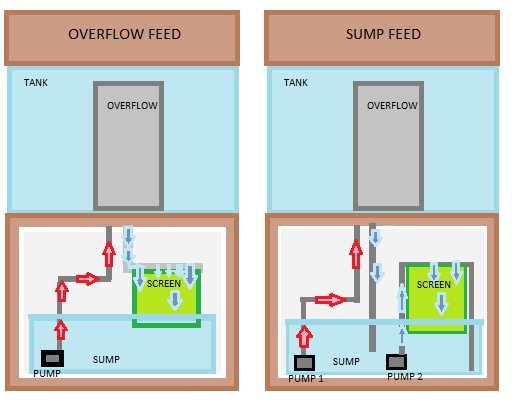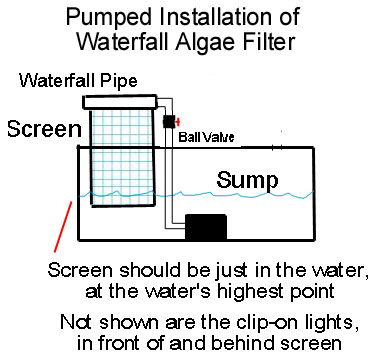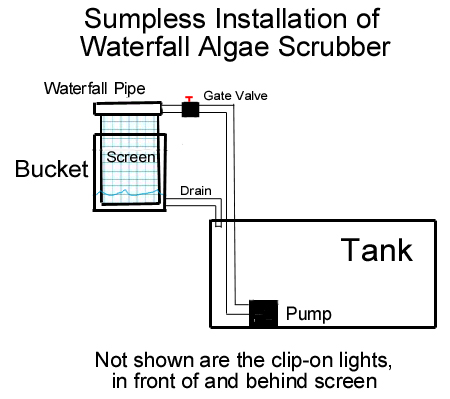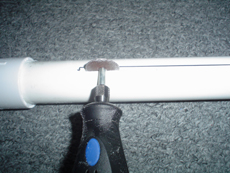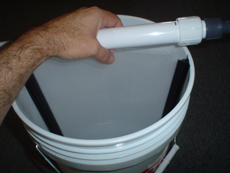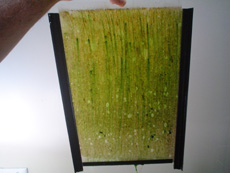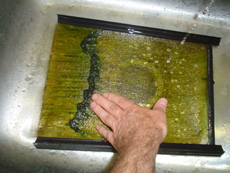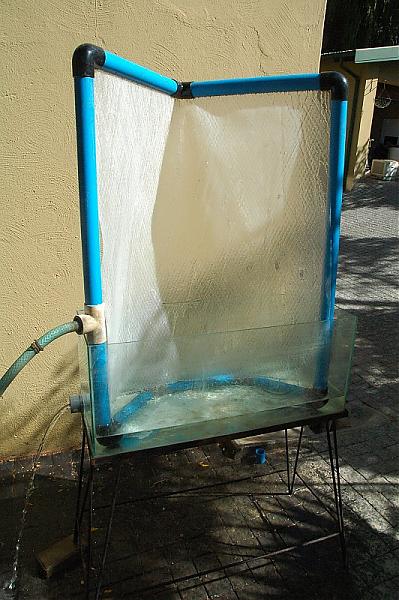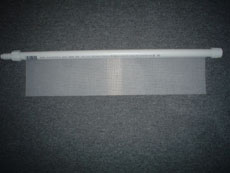Part 1 of 2:
Mega Powerful Nitrate and Phosphate Remover - DIY!
Are you tired of green on your rocks? Do you have to clean your glass more than once a week? Well then I'm sure you've been told (or you've figured out) that your Nitrate and/or Phosphate are too high. Sure enough, if these are too high, the green starts growing. Phosphate is the important one: If you can detect any phosphate at all with a hobby test kit (like Salifert), then it's high enough to cause algae to grow. So, what can you do?
Build an algae filter screen, that's what you can do. An algae filter screen, also known as a turf algae filter, a turf scrubber, or an algae scrubber, basically filters the water clean of nitrate and phosphate so that the green on your rocks and glass goes away. It does this by "moving" the growth of the algae from the tank to a "screen" outside of the tank. The idea is that you create a better growing environment on the screen than occurs in the tank, so that the algae grows on the screen instead. It works great!
Here's what you can expect: If you build your algae filter properly, your nitrate and phosphate will be incredibly low, sometimes unmeasureable by hobby test kits, within four weeks. I use Salifert test kits, and the readings I get are "clear" (zero) for both the Nitrate and the Phosphate tests. This is what you want. If you have been trying to get this yourself, then an algae filter is for you.
Here is my Algae Filter in a 5-gallon bucket; it's the only filter I have (other than the live rock) on my 100 gallon reef:
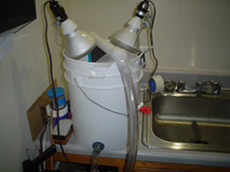
Here is the filter in operation with the lights on:
[pic limit]
Here is my tank:

Hi-Res: http://www.radio-media.com/fish/WholeTank.jpg
Video: http://www.radio-media.com/fish/WholeTank08-11-08.mpg
And here are the only things you need to build a bucket version of this filter:
[pic limit]
My nitrate and phosphate are zero (clear on Salifert test kits), and the only thing in my sump is water. I removed the skimmer, carbon, phosban, polyfilter(s), and filtersock; I don't use ozone, vodka, zeo or anything else. I'm feeding massive amounts too; enough that if I had my previous filtering setup, I'd have to clean the glass twice a day, and everything in the tank would be covered in green or brown algae. Amazing.
The only thing you need to decide on is how big your algae filter screen needs to be, and if you want it to be in your tank's hood, or in a bucket, or in your sump. The basic rule is one square inch of screen for each gallon of tank water, if the screen it lit on both sides; the screen size should be twice this if the screen is lit up on just one side. A 12 X 12 inch screen, lit both sides, = 144 square inches = 144 gal tank; a 7 X 7 inch screen lit both sides = 49 gal tank; a 6 X 6 lit both sides = 36 gal tank. Algae filters get really small as you can see. A 12 gal nano tank needs just 3 X 4 inches! This small thing can replace the skimmer, refugium, phosphate removers, nitrate removers, carbon, filtersocks, and waterchanges, IF THE PURPOSE of these devices is to reduce nitrate and phosphate. If these devices have any other purpose, then they can't be replaced. If your tank is bigger than a 75, then just start with a 5 gallon bucket size and see how it goes. You can always add a second one, or build a bigger one later.
My example bucket version takes about 4 hours to build. Water goes in the pvc pipe at the top, flows down over the screen, then drains out the bottom. That's it! Oh, and it has clip-on lights. I can feed the tank a lot of food, and anything not eaten by the corals or fish eventually ends up as algae on the screen.
Here are some examples of DIY algae filter screens already built, from a simple nano one:
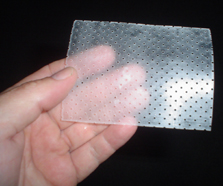
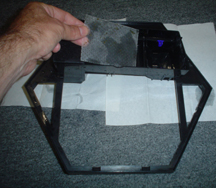
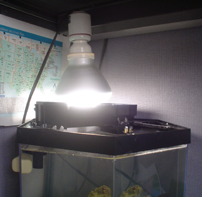
to larger ones:
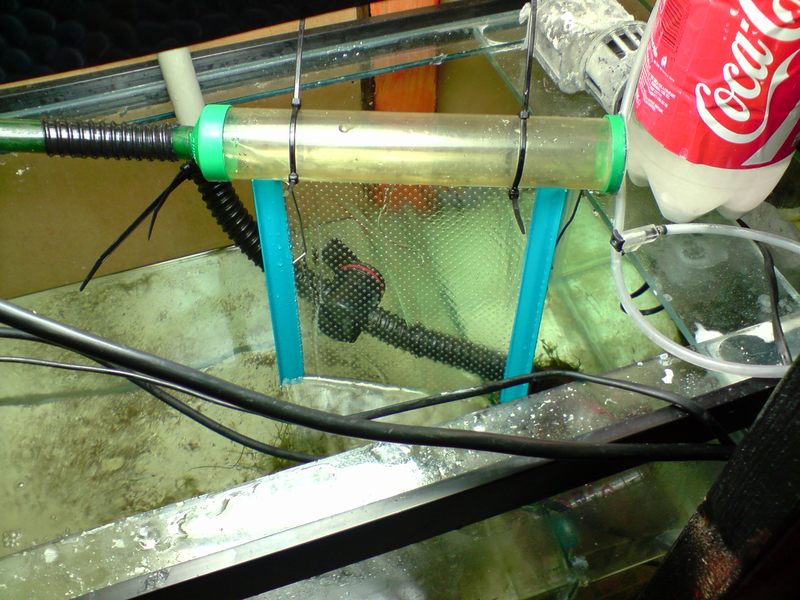
[pic limit]
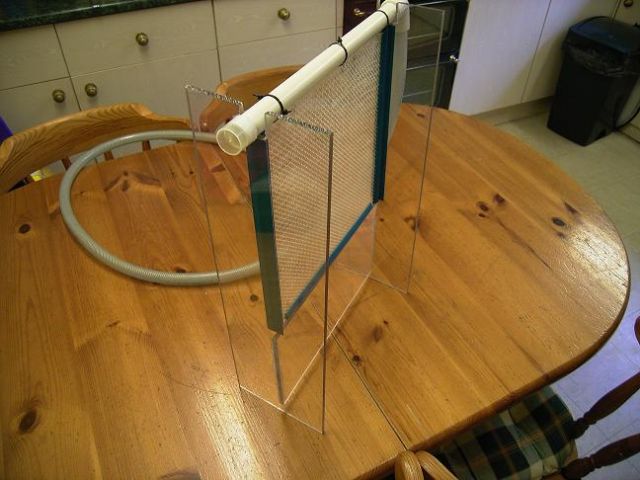
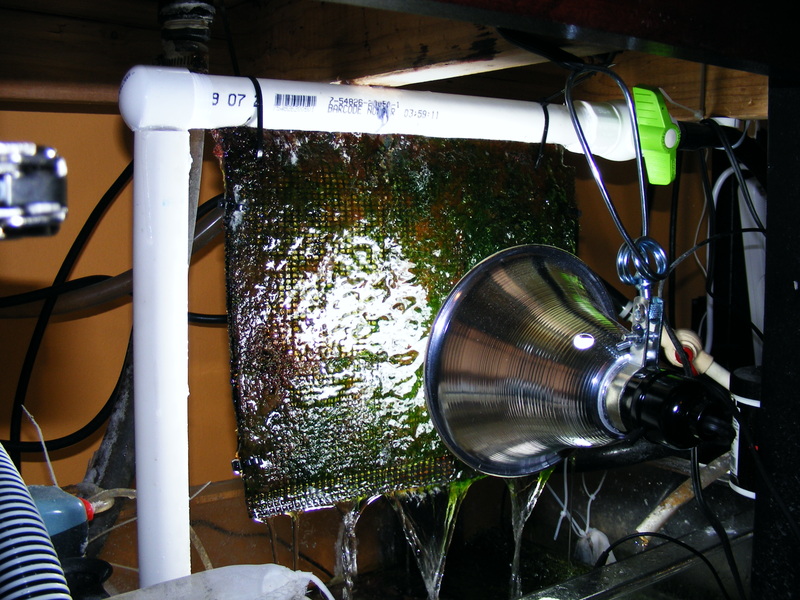
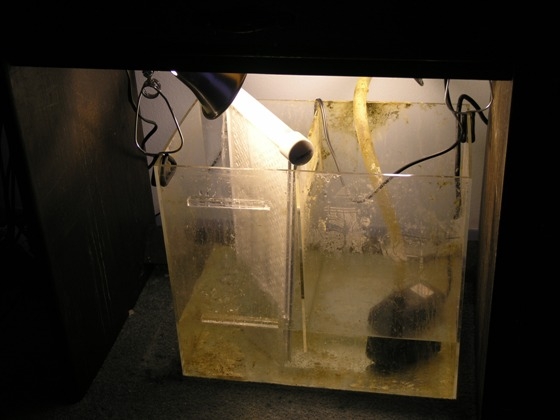
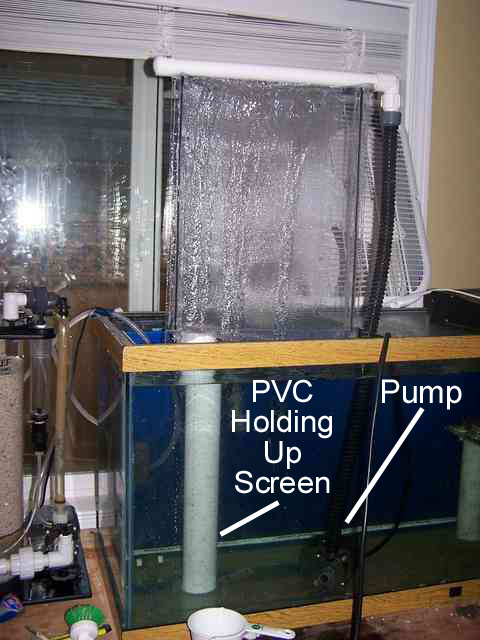
Here are some advantages of an algae filter:
o Allows you to feed very high amounts without causing nuisance algae growth in the tank.
o Can replace waterchanges, IF THE PURPOSE of the waterchange is to reduce nitrate or
phosphate or algae growth. Otherwise, it does not replace the water change.
o Grows swarms of copepods.
o Increases pH.
o Increases oxygen.
o Will NOT spread algae into the tank. It removes algae FROM the tank.
o There is no odor from the algae (only a slight ocean smell when cleaning it).
o Is very quiet when flowing, similar to a tabletop decorative waterfall.
o Introduces no microbubbles when adjusted.
o Removes ammonia too.
o You can even make a portable bucket! Just unplug the lights, lift up the pump
out of the tank water, and go put it in your next tank (or your friend's tank).
Don't let the screen dry out though.
o Works in saltwater or freshwater.
Mega Powerful Nitrate and Phosphate Remover - DIY!
Are you tired of green on your rocks? Do you have to clean your glass more than once a week? Well then I'm sure you've been told (or you've figured out) that your Nitrate and/or Phosphate are too high. Sure enough, if these are too high, the green starts growing. Phosphate is the important one: If you can detect any phosphate at all with a hobby test kit (like Salifert), then it's high enough to cause algae to grow. So, what can you do?
Build an algae filter screen, that's what you can do. An algae filter screen, also known as a turf algae filter, a turf scrubber, or an algae scrubber, basically filters the water clean of nitrate and phosphate so that the green on your rocks and glass goes away. It does this by "moving" the growth of the algae from the tank to a "screen" outside of the tank. The idea is that you create a better growing environment on the screen than occurs in the tank, so that the algae grows on the screen instead. It works great!
Here's what you can expect: If you build your algae filter properly, your nitrate and phosphate will be incredibly low, sometimes unmeasureable by hobby test kits, within four weeks. I use Salifert test kits, and the readings I get are "clear" (zero) for both the Nitrate and the Phosphate tests. This is what you want. If you have been trying to get this yourself, then an algae filter is for you.
Here is my Algae Filter in a 5-gallon bucket; it's the only filter I have (other than the live rock) on my 100 gallon reef:

Here is the filter in operation with the lights on:
[pic limit]
Here is my tank:

Hi-Res: http://www.radio-media.com/fish/WholeTank.jpg
Video: http://www.radio-media.com/fish/WholeTank08-11-08.mpg
And here are the only things you need to build a bucket version of this filter:
[pic limit]
My nitrate and phosphate are zero (clear on Salifert test kits), and the only thing in my sump is water. I removed the skimmer, carbon, phosban, polyfilter(s), and filtersock; I don't use ozone, vodka, zeo or anything else. I'm feeding massive amounts too; enough that if I had my previous filtering setup, I'd have to clean the glass twice a day, and everything in the tank would be covered in green or brown algae. Amazing.
The only thing you need to decide on is how big your algae filter screen needs to be, and if you want it to be in your tank's hood, or in a bucket, or in your sump. The basic rule is one square inch of screen for each gallon of tank water, if the screen it lit on both sides; the screen size should be twice this if the screen is lit up on just one side. A 12 X 12 inch screen, lit both sides, = 144 square inches = 144 gal tank; a 7 X 7 inch screen lit both sides = 49 gal tank; a 6 X 6 lit both sides = 36 gal tank. Algae filters get really small as you can see. A 12 gal nano tank needs just 3 X 4 inches! This small thing can replace the skimmer, refugium, phosphate removers, nitrate removers, carbon, filtersocks, and waterchanges, IF THE PURPOSE of these devices is to reduce nitrate and phosphate. If these devices have any other purpose, then they can't be replaced. If your tank is bigger than a 75, then just start with a 5 gallon bucket size and see how it goes. You can always add a second one, or build a bigger one later.
My example bucket version takes about 4 hours to build. Water goes in the pvc pipe at the top, flows down over the screen, then drains out the bottom. That's it! Oh, and it has clip-on lights. I can feed the tank a lot of food, and anything not eaten by the corals or fish eventually ends up as algae on the screen.
Here are some examples of DIY algae filter screens already built, from a simple nano one:



to larger ones:

[pic limit]




Here are some advantages of an algae filter:
o Allows you to feed very high amounts without causing nuisance algae growth in the tank.
o Can replace waterchanges, IF THE PURPOSE of the waterchange is to reduce nitrate or
phosphate or algae growth. Otherwise, it does not replace the water change.
o Grows swarms of copepods.
o Increases pH.
o Increases oxygen.
o Will NOT spread algae into the tank. It removes algae FROM the tank.
o There is no odor from the algae (only a slight ocean smell when cleaning it).
o Is very quiet when flowing, similar to a tabletop decorative waterfall.
o Introduces no microbubbles when adjusted.
o Removes ammonia too.
o You can even make a portable bucket! Just unplug the lights, lift up the pump
out of the tank water, and go put it in your next tank (or your friend's tank).
Don't let the screen dry out though.
o Works in saltwater or freshwater.


